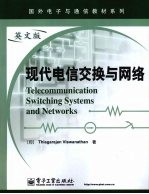图书介绍
Telecommunication switching systems and networks 英文版PDF|Epub|txt|kindle电子书版本网盘下载

- (印) Thiagarajan Viswanathan著 著
- 出版社: 北京:电子工业出版社
- ISBN:9787121079894
- 出版时间:2009
- 标注页数:411页
- 文件大小:26MB
- 文件页数:430页
- 主题词:通信交换-教材-英文;通信网-教材-英文
PDF下载
下载说明
Telecommunication switching systems and networks 英文版PDF格式电子书版下载
下载的文件为RAR压缩包。需要使用解压软件进行解压得到PDF格式图书。建议使用BT下载工具Free Download Manager进行下载,简称FDM(免费,没有广告,支持多平台)。本站资源全部打包为BT种子。所以需要使用专业的BT下载软件进行下载。如BitComet qBittorrent uTorrent等BT下载工具。迅雷目前由于本站不是热门资源。不推荐使用!后期资源热门了。安装了迅雷也可以迅雷进行下载!
(文件页数 要大于 标注页数,上中下等多册电子书除外)
注意:本站所有压缩包均有解压码: 点击下载压缩包解压工具
图书目录
Chapter 1 Introduction1
1.1 Evolution of Telecommunications1
1.2 Simple Telephone Communication5
1.3 Basics of a Switching System8
1.4 Manual Switching System11
1.5 Major Telecommunication Networks15
Further Reading18
Exercises18
Chapter 2 Strowger Switching Systems20
2.1 Rotary Dial Telephone20
2.2 Signalling Tones23
2.3 Strowger Switching Components25
2.4 Step-by-Step Switching29
2.5 Design Parameters33
2.6 100-line Switching System34
2.6.1 Design 135
2.6.2 Design 236
2.6.3 Design 336
2.6.4 Design 437
2.6.5 Design 538
2.7 1000-line Blocking Exchange39
2.8 10,000-line Exchange42
Further Reading42
Exercises42
Chapter 3 Crossbar Switching44
3.1 Principles of Common Control44
3.2 Touch Tone Dial Telephone48
3.2.1 Design Considerations49
3.3 Principles of Crossbar Switching52
3.4 Crossbar Switch Configurations54
3.5 Crosspoint Technology56
3.6 Crossbar Exchange Organisation58
Further Reading59
Exercises59
Chapter 4 Electronic Space Division Switching81
4.1 Stored Program Control61
4.2 Centralised SPC62
4.3 Distributed SPC68
4.3.1 Level 3 Processing68
4.3.2 Level 2 Processing69
4.3.3 Level 1 Processing70
4.4 Software Architecture71
4.5 Application Software79
4.6 Enhanced Services84
4.7 Two-Stage Networks89
4.8 Three-Stage Networks92
4.9 n-Stage Networks96
Further Reading97
Exercises97
Chapter 5 Speech Digitisation and Transmission99
5.1 Sampling99
5.2 Quantisation and Binary Coding101
5.3 Quantisation Noise103
5.4 Companding105
5.5 Differential Coding109
5.6 Vocoders111
5.7 Pulse Transmission112
5.8 Line Coding119
5.9 Time Division Multiplexing123
Further Reading126
Exercises126
Chapter 6 Time Division Switching128
6.1 Basic Time Division Space Switching128
6.2 Basic Time Division Time Switching133
6.3 Time Multiplexed Space Switching140
6.4 Time Multiplexed Time Switching144
6.5 Combination Switching150
6.6 Three-Stage Combination Switching152
6.7 n-Stage Combination Switching155
Further Reading157
Exercises157
Chapter 7 Optical Fibre Systems159
7.1 Types of Optical Fibres159
7.2 Fibre Optic Transmission162
7.3 Optical Sources166
7.3.1 Light Emitting Diodes168
7.3.2 Laser Diodes172
7.4 Optical Detectors175
7.4.1 p-i-n Photodiode178
7.4.2 Avalanche Photodiode180
7.5 Power Budget Analysis183
7.6 Telecommunication Applications187
Further Reading189
Exercises189
Chapter 8 Traffic Engineering191
8.1 Network Traffic Load and Parameters191
8.2 Grade of Service and Blocking Probability195
8.3 Modelling Switching Systems196
8.3.1 Markov Processes198
8.3.2 Birth-death Processes199
8.4 Incoming Traffic and Service Time Characterisation201
8.5 Blocking Models and Loss Estimates205
8.5.1 Lost Calls Cleared System with Infinite Sources205
8.5.2 Lost Calls Cleared System with Finite Subscribers208
8.5.3 Lost Calls Returned System212
8.5.4 Lost Calls Held System212
8.6 Delay Systems213
Further Reading218
Exercises218
Chapter 9 Telephone Networks221
9.1 Subscriber Loop Systems221
9.2 Switching Hierarchy and Routing227
9.3 Transmission Plan229
9.4 Transmission Systems233
9.4.1 Ionospheric Communication233
9.4.2 Microwave Communication237
9.4.3 Tropospheric Scatter Communication244
9.4.4 Satellite Communications245
9.4.5 Coaxial Cable Transmission249
9.5 Numbering Plan252
9.6 Charging Plan256
9.7 Signalling Techniques259
9.8 Inchannel Signalling263
9.9 Common Channel Signalling268
9.10 Cellular Mobile Telephony272
Further Reading274
Exercises274
Chapter 10 Data Networks277
10.1 Data Transmission in PSTNs278
10.1.1 Data Rates in PSTNs279
10.1.2 Modems281
10.2 Switching Techniques for Data Transmission283
10.2.1 Circuit Switching284
10.2.2 Store and Forward Switching287
10.3 Data Communication Architecture291
10.3.1 ISO-OSI Reference Model292
10.4 Link-to-link Layers297
10.4.1 Physical Layer298
10.4.2 Data Link Layer298
10.4.3 Network Layer304
10.5 End-to-End Layers306
10.5.1 Transport Layer306
10.5.2 Session Layer307
10.5.3 Presentation Layer308
10.5.4 Application Layer311
10.6 Satellite Based Data Networks313
10.7 Local Area Networks317
10.7.1 LAN Technologies318
10.7.2 Multiple Access Bus LAN319
10.7.3 Token Passing Ring LAN323
10.7.4 Token Passing Bus LAN325
10.8 Metropolitan Area Networks326
10.9 Fibre Optic Networks328
10.10 Data Network Standards332
10.11 Protocol Stacks337
10.11.1 Manufacturing Automation Protocol(MAP)337
10.11.2 Technical and Office Protocol(TOP)339
10.11.3 Library Automation Protocol(LAP)339
10.12 Internetworking339
Further Reading341
Exercises341
Chapter 11 Integrated Services Digital Network345
11.1 Motivation for ISDN346
11.2 New Services347
11.2.1 Videotex348
11.2.2 Electronic Mail348
11.2.3 Facsimile353
11.2.4 Teletex355
11.2.5 Database Access356
11.3 Network and Protocol Architecture357
11.4 Transmission Channels362
11.5 User-Network Interfaces363
11.5.1 Functional Grouping and Reference Points365
11.6 Signalling366
11.6.1 User Level Signalling367
11.6.2 Network Level Signalling368
11.7 Numbering and Addressing370
11.7.1 Address Structure370
11.8 Service Characterisation371
11.9 Interworking374
11.9.1 Numbering Interworking376
11.10 ISDN Standards377
11.11 Expert Systems in ISDN380
11.11.1 Components of an Expert System382
11.11.2 Example of an Expert System384
11.12 Broadband ISDN385
11.12.1 Broadband ISDN Architecture385
11.12.2 Broadband ISDN Protocols387
Further Reading388
Exercises388
Chapter 12 Asynchronous Transfer Mode391
12.1 Protocol Architecture391
12.2 ATM Logical Connections392
12.2.1 Virtual Channel Connection Uses392
12.2.2 Virtual Path/Virtual Channel Characteristics394
12.2.3 Control Signalling394
12.3 ATM Cells395
12.3.1 Header Format395
12.3.2 Generic Flow Control397
12.3.3 Header Error Control398
12.4 Transmission of ATM Cells399
12.4.1 Cell-Based Physical Layer399
12.4.2 SDH-Based Physical Layer400
12.5 ATM Service Categories402
12.5.1 Real-Time Services402
12.5.2 Non-Real-Time Services403
Chapter 13 Softswitch and Next Generation Network(NGN)404
13.1 Softswitch404
13.2 Next Generation Networking404
13.2.1 Description404
13.2.2 Underlying technology components405
13.2.3 NGN Functional Architecture406
13.3 Applications407
Answers to Selected Exercises408